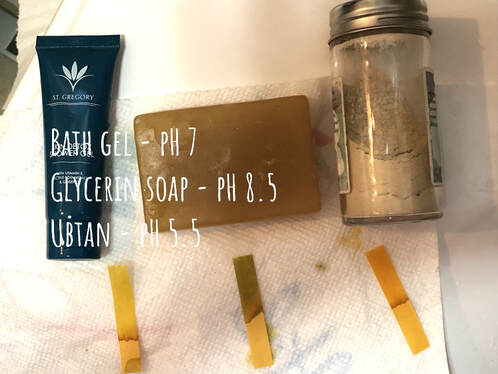|
I grew up in India, the country that gave the world Ayurveda. Ayurveda is a medical system that is based on the tenet that human disease is caused by the imbalance of “Doshas” and the disease should be treated using predominantly plants and herbs (roots and bark etc.) to bring the doshas back into balance. Ayurvedic skincare is enjoying a reawakening (much like Yoga) and is all the rage today due to its esoteric appeal. There is quite a bit of debate regarding the efficacy of Ayurvedic treatment - see this paper for example. The core issue seems to be lack of regulation of the ingredients used in Ayurvedic medicine and the lack of clinical trials that clearly establish efficacy of such treatment. Despite being born and raised in the land of Ayurveda, I will admit I have a healthy skepticism for Ayurveda - concepts like Doshas are hard for scientists to accept. In many Indian households (including mine growing up), using herbs and plants for daily skin and hair care was fairly common. I remember vividly my mother cooking an oil with herbs like curry leaves, henna, hibiscus, Eclipta Alba (or karasillankanni aka bhringraj) and giving me regular oil massages with the dark concoction that smelled ... like a bunch of herbs. She would also use a bunch of Ayurvedic oils for body massages, make a paste of chick pea flour and turmeric to cleanse (until I was grown enough to declare this the most unsexy thing to cleanse with and switched to fragrant soaps). With that rather long story, I now come to the point of this post - how to cleanse skin the right way. Modern science gave us soap - a product formed by the sapinification of fatty oils using sodium hydroxide (or lye). The way soap works is by emulsifying dirt that sticks to our skin via the sebum - an oily substance that protects our skin. Sodium hydroxide is a highly alkaline substance - meaning it’s highly abrasive. Many cleaning substances such as the Comet cleaning powder, are highly alkaline which is why they are effective as cleaners. Typically the pH of soap is 9, that of water is around 7 (neutral pH) and that of sulfuric acid as present in battery acid, is 1. Strong acids and bases are abrasive and good for cleaning things - but not our skin! When you use a strong alkaline substance to cleanse your skin, you do effectively get dirt off. But you also strip your skin off its protective sebum making you feel very dry. The other interesting fact is that your skin is actually slightly acidic with a pH of less than 5! I remember being amazed when I first read about this. This paper shows that even bathing with hard water (that’s more alkaline) can impact the acid mantle of the skin. So why is disturbing the skin’s pH not good? Because doing so (by using alkaline products) can disturb the skin’s micro flora - the bacteria - that live on our skin. Turns out that not all bacteria are bad - and we need these bacteria to have healthy skin. Disrupting the skin’s micro flora can lead to a variety of skin problems like eczema etc. So long story short, if you’re using soap to cleanse, stop. What about liquid cleansers? These are made of a cocktail of surfactants. There are a lot of liquid cleansers in the market now that are more gentle than soap - see this nice article by labmuffin for a review. I checked the pH of some shower gels I had (picked up from hotels) and found the pH to be generally between 6 and 7. Not bad! However, it feels convoluted to make a cocktail of surfactants, add preservatives since these liquid cleansers are water based, (I am allergic to a particular preservative that is commonly used - phenoxyethanol), and add an acid (generally citric acid) to balance the pH. Below is the list of ingredients in a typical liquid cleanser; I don’t like the complexity of this product. As I continue my journey into skin care formulation, I was drawn to Ayurvedic formulation of oils etc. The methodology of extracting herbal essences in a polar solvent (like water) and then boiling off the solvent in an oil is a very effective way to get a decent concentration of the plant material in a pH neutral medium without the need of a preservative. This type of elegant formulation is highly appealing to me and that’s how I embarked on a mission to research Ayurvedic formulation. In Ayurveda, the method of skin cleansing involves using a paste made of powders - typically a base chick pea flour - that can be customized endlessly. Such a paste is called Ubtan. I was pleasantly surprised to find a paper on the antioxidant properties, pH etc. of an ubtan featuring chickpea flour, turmeric, and sandalwood bark powder. The pH of this ubtan is 6.5, pretty decent for skin. Below is the comparison of the pH of soap, a bath gel, and the Ubtan I have made. The Ubtan is closer to our skin pH and what’s more, you can make one that feels luxurious and smells great. I use a very mild surfactant to give the Ubtan a “soapy” feel and appearance but is totally optional. You can also use a few drops of an essential oil to add to the fragrance if you do desire.
1 Comment
I like to take care of my health, both physical and mental. To avoid deficiencies, I had to adopt a balanced diet and above all use a specific food supplement. It is on this article that I found the product that allowed me to relive and enjoy optimal well-being without health concerns.
Reply
Leave a Reply. |
|
|
© Saroya Natural 2023 | All rights reserved.
Website designed by Aadi M |
Contact Us |





 RSS Feed
RSS Feed